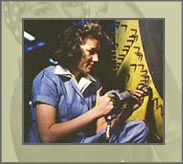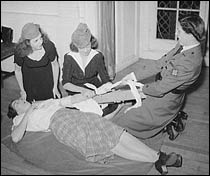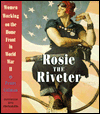| |
Overview
By Penny Colman
 Riveting was one of the jobs taken on by women in the war industry,
like this woman working on a Consolidated bomber in Fort Worth,
Texas, 1942. Photo Credit: Library of Congress
Riveting was one of the jobs taken on by women in the war industry,
like this woman working on a Consolidated bomber in Fort Worth,
Texas, 1942. Photo Credit: Library of Congress |
One of the most
dramatic changes during World War II was the number of women who
went to work. As the armed forces filled its ranks with manpower,
industry filled its jobs with womanpower. For the duration
of the war, the U.S. government and industry wooed American women
to work in the war effort. The title of a song, "Rosie
the Riveter," quickly became the catchphrase that represented
all women war workers.
During World War II, more
than six million women joined the workforce. In August 1943, Newsweek
magazine reported: "They [women] are in the shipyards, lumber mills,
steel mills, foundries. They are welders, electricians, mechanics,
and even boilermakers. They operate streetcars, buses, cranes, and
tractors. Women engineers are working in the drafting rooms and
women physicists and chemists in the great industrial laboratories."
More than two million women joined the war effort as clerical workers,
nearly one million of whom were hired by the federal government.
Women also became police officers, taxicab drivers, lawyers, statisticians,
journalists, and members of symphony orchestras, as men left for
the armed forces. Women ran farms, planted crops, tended animals,
and harvested tons of vegetables, fruits, and grains.

Volunteers for the Civilian Defense took classes on how to care
for the wounded, like these women in a first aid class in New
York City in 1941.
Photo Credit: Library of Congress |
In addition,
three million women served as Red Cross volunteers. Millions of
women worked for the Civilian Defense as air-raid
wardens, fire
watchers messengers, drivers, auxiliary
police. Women volunteers also devoted hours to scanning the
sky with binoculars, looking out for enemy planes. Thousands of
women joined the military through organizations like the Women's
Auxiliary Ferrying Squadron (WAFS) and the Women Airforce Service
Pilots (WASP), the Women
Accepted for Volunteer Emergency Service (WAVES), and the Women's
Army Corps (WAC).
About the time
World War II ended, American factories had produced 296,429 airplanes,
102,351 tanks and self-propelled guns, 372,431 artillery pieces,
47 million tons of artillery ammunitions, 87,620 warships, and 44
billion rounds of small-arms ammunition. Time magazine called
America's wartime production a miracle. The "miracle" would not
have happened without Rosie the Riveter.

Penny Colman is the author of Rosie the Riveter: Women Working on the Home Front in World War II. |
When the war
ended in 1945, so did America's need for women workers. Rosie the
Riveter disappeared as quickly as she had been created, but her
memory lived on. Although America no longer needed women workers,
the story of their wartime achievements and contributions to the
war effort lives on in employment records and in statistics; in
magazine and newspaper articles and on radio programs; and in thousands
of posters, pamphlets, and photographs. This is an amazing story
about a time when traditional barriers that had blocked women workers
were lowered, and when women finally had a chance to prove what
they could do on a national scale.
Betty Reilly's
story is just one woman's experience of living during the war and
working in a plant building PT boats. Every "Rosie the Riveter"
has her own story to tell. This is Betty's.

|
|

